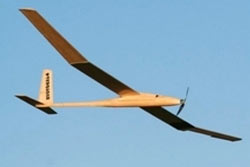Horizon Fuel Cell Technologies has broken the distance record for a small unmanned aerial vehicle (UAV) or "drone" flight after it travelled 78 miles powered by Horizon's technology.
The company said the aircraft flew 28 miles further than the previous record-holding journey for a micro UAV and did so using just a quarter of the hydrogen tank capacity stored on board.
It added that with a full fuel tank the aircraft, codenamed Pterosoar, would boast a range of 500km with the fuel cell delivering 480w per kilogram, or 2.6 better energy density that the best available batteries.
"Due to our best-in-class fuel cell power density, we have been able to dedicate approximately 80 per cent of the total power system volume to hydrogen storage using pre-filled pressurised hydrogen tanks to achieve record breaking results," said Horizon chief executive George Gu. "However, we plan to employ more advanced forms of hydrogen storage, [which will further reduce the size of the power system]."
Fuel cell powered UAVs have garnered interest from the military and police, which have been attracted more by the technology's potential to increase flight times, improve reliability and reduce the chances of detection by cutting noise and heat signatures, than by its lack of carbon emissions.
Horizon said it was now well positioned to exploit the growing market for UAVs, which is estimated to be worth $54bn over the next decade.
But while improvements in the fuel cell's energy density could make hydrogen-powered UAV's competitive, experts remain convinced that Horizon's test flight is not the precursor to a new generation of manned zero-carbon planes.
Henry DeRonck, general manager for space and defence at fuel cell specialist UTC Power, said that the size of fuel tank required for a fuel cell powered manned flight made the technology unviable even before considering the problem posed by supplying sufficient hydrogen and compressing the air at high altitudes.
However, he added that there were some areas where the wider aviation industry was investigating using fuel cells, most notably as a possible source of emergency power for flights and as a means of generating more efficient power for non-flight applications on board.

